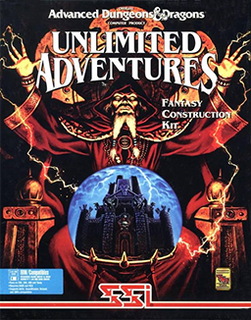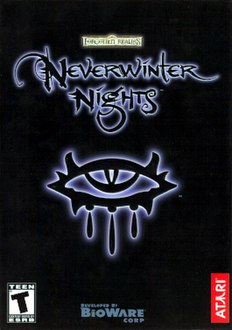Forgotten Realms is a campaign setting for the Dungeons & Dragons (D&D) fantasy role-playing game. Commonly referred to by players and game designers alike as "The Realms", it was created by game designer Ed Greenwood around 1967 as a setting for his childhood stories. Several years later, Greenwood brought the setting to publication for the D&D game as a series of magazine articles, and the first Realms game products were released in 1987. Role-playing game products have been produced for the setting ever since, as have various licensed products including novels, role-playing video game adaptations, and comic books.

Pool of Radiance is a role-playing video game developed and published by Strategic Simulations, Inc (SSI) in 1988. It was the first adaptation of TSR's Advanced Dungeons & Dragons (AD&D) fantasy role-playing game for home computers, becoming the first episode in a four-part series of D&D computer adventure games. The other games in the "Gold Box" series used the game engine pioneered in Pool of Radiance, as did later D&D titles such as the Neverwinter Nights online game. Pool of Radiance takes place in the Forgotten Realms fantasy setting, with the action centered in and around the port city of Phlan.

Forgotten Realms: Unlimited Adventures, also known as Unlimited Adventures, or by the acronyms FRUA or UA, is a video game originally released on March 17, 1993, by Strategic Simulations, Inc. for the IBM PC and Apple Macintosh.

Neverwinter Nights is a third-person role-playing video game developed by BioWare. Interplay Entertainment was originally set to publish the game, but financial difficulties led to it being taken over by Infogrames, who released the game under their Atari range of titles. It was released for Microsoft Windows on June 18, 2002. BioWare later released a Linux client in June 2003, requiring a purchased copy of the game to play. MacSoft released a Mac OS X port in August 2003.

Eye of the Beholder is a role-playing video game for personal computers and video game consoles developed by Westwood Associates. It was published by Strategic Simulations, Inc. in 1991 for the MS-DOS operating system and later ported to the Amiga, the Sega CD and the SNES. The Sega CD version features a soundtrack composed by Yuzo Koshiro. A port to the Atari Lynx handheld was developed by NuFX in 1993, but was not released. In 2002, an adaptation of the same name was developed by Pronto Games for the Game Boy Advance.

Gold Box is a series of role-playing video games produced by SSI from 1988 to 1992. The company acquired a license to produce games based on the Advanced Dungeons & Dragons role-playing game from TSR, Inc. These games shared a common engine that came to be known as the "Gold Box Engine" after the gold-colored boxes in which most games of the series were sold.

The Keep on the Borderlands is a Dungeons & Dragons adventure module by Gary Gygax, first printed in December 1979. In it, player characters are based at a keep and investigate a nearby series of caves that are filled with a variety of monsters. It was designed to be used with the Dungeons & Dragons Basic Set, and was included in the 1979–1982 editions of the Basic Set. It was designed for people new to Dungeons & Dragons.

An owlbear is a fictional creature originally created for the Dungeons & Dragons fantasy role-playing game. An owlbear is depicted as a cross between a bear and an owl, which "hugs" like a bear and attacks with its beak. Inspired by a plastic toy made in Hong Kong, Gary Gygax created the owlbear and introduced the creature to the game in the 1975 Greyhawk supplement; the creature has since appeared in every subsequent edition of the game. Owlbears, or similar beasts, also appear in several other fantasy role-playing games, video games and other media.

Neverwinter Nights 2 is a role-playing video game developed by Obsidian Entertainment and published by Atari. It is the sequel to BioWare's Neverwinter Nights, based on the Dungeons & Dragons pencil and paper fantasy role-playing game. Neverwinter Nights 2 utilizes an adaptation of the Dungeons & Dragons 3.5 edition rules. Players create player characters to represent themselves in the game, using the same character creation rules as found in the Dungeons & Dragons game. They may gain the assistance of additional party members, and they eventually acquire a keep that can be used as a base of operations. Neverwinter Nights 2 is set in the Forgotten Realms campaign setting—in and around the city of Neverwinter. The story is mostly unrelated to Neverwinter Nights and follows the journey of an orphaned adventurer investigating a group of mysterious artifacts known as "silver shards" and their connection to an ancient, evil spirit known as the King of Shadows.

Stormfront Studios, Inc. was an American video game developer based in San Rafael, California. In 2007, the company had over 50 developers working on two teams, and owned all its proprietary engines, tools, and technology. As of the end of 2007, over fourteen million copies of Stormfront-developed games had been sold. Stormfront closed on March 31, 2008, due to the closure of their publisher at the time, Sierra Entertainment.

Don Daglow is an American computer game and video game designer, programmer and producer. He is best known for being the creator of early games from several different genres, including pioneering simulation game Utopia for Intellivision in 1981, role-playing game Dungeon in 1975, sports games including the first interactive computer baseball game Baseball in 1971, and the first graphical MMORPG, Neverwinter Nights in 1991. He founded long-standing game developer Stormfront Studios in 1988.

Gateway to the Savage Frontier (1991) is a Gold BoxDungeons and Dragons computer game developed by Beyond Software and published by SSI for the Commodore 64, PC and Amiga personal computers.

Treasures of the Savage Frontier (1992) is a Gold Box Dungeons and Dragons role-playing video game. It was developed by Beyond Software and published by SSI for the Amiga and DOS.
Cathryn Mataga is a game programmer and founder of independent video game company Junglevision. Under the name William, she wrote Atari 8-bit computer games for Synapse Software in the early to mid 1980s, including Shamus, the flip-screen shooter video game.

Neverwinter Nights was the first multiplayer online role-playing game to display graphics, and ran from 1991 to 1997 on AOL.

Neverwinter Nights 2: Storm of Zehir is an expansion pack for the role-playing video game Neverwinter Nights 2, developed by Obsidian Entertainment and published by Atari. It was released in late 2008 in North America, Europe, and Australia. Like previous entries in the Neverwinter Nights series, Storm of Zehir is based on the paper and pencil fantasy role-playing game Dungeons & Dragons, and uses the game's 3.5 edition ruleset.

Neverwinter Nights is a series of video games developed by BioWare and Obsidian Entertainment, based on the Forgotten Realms campaign setting of the Dungeons & Dragons role-playing game. It is unrelated to the 1991 Neverwinter Nights online game hosted by AOL.
A non-player character (NPC) is any character in a game which is not controlled by a player. The term originated in traditional tabletop role-playing games where it applies to characters controlled by the gamemaster or referee rather than another player. In video games, this usually means a character controlled by the computer that has a predetermined set of behaviors that potentially will impact gameplay, but will not necessarily be true artificial intelligence.
Western role-playing video games are role-playing video games developed in the Western world, including The Americas and Europe. They originated on mainframe university computer systems in the 1970s, were later popularized by titles such as Ultima and Wizardry in the early- to mid-1980s, and continue to be produced for modern home computer and video game console systems. The genre's "Golden Age" occurred in the mid- to late-1980s, and its popularity suffered a downturn in the mid-1990s as developers struggled to keep up with changing fashion, hardware evolution and increasing development costs. A later series of isometric role-playing games, published by Interplay Productions and Blizzard Entertainment, was developed over a longer time period and set new standards of production quality.













